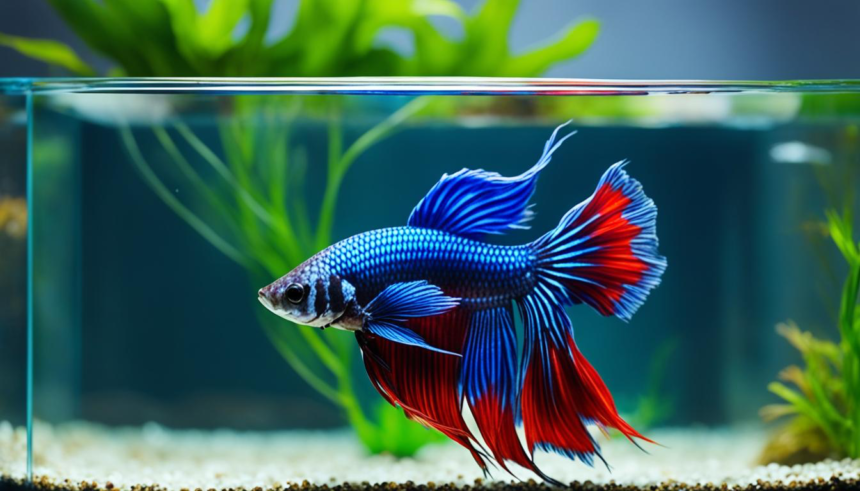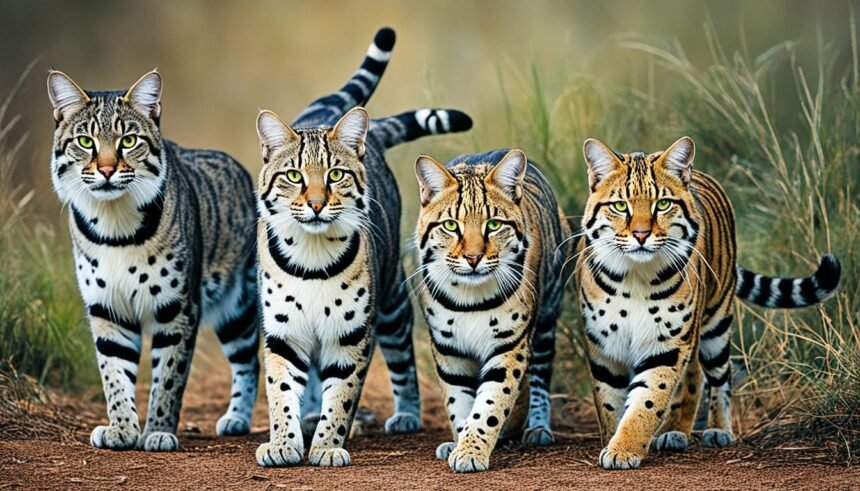The wels catfish is Europe’s largest freshwater fish. It amazes everyone with its size, growing up to more than 200 kg. Such giants spark stories of mysterious creatures living underwater.
Found in Europe’s rivers and lakes, the wels catfish is a marvel. It’s much larger than most fish we know. This fish symbolizes the wild, unexplored parts of our waters.
Introduction to the Wels Catfish
The wels catfish, also known as Silurus glanis, is a fascinating fish found in Europe’s freshwaters. This fish lives in many parts of Europe. Places like the Baltic, Black, and Caspian Seas are its home. It has also traveled to areas like the UK and as far as Kazakhstan, China, Greece, and Turkey.
Fishers highly value the wels catfish for sport. It’s big, tough, and offers a good challenge. Anglers from many places seek it as a prize catch. Not only fishermen but also TV shows have noticed this fish. They admire it for its size and unique features.
| Country | Introduced | Reason for Introduction | Current Status |
|---|---|---|---|
| United Kingdom | Yes | Sport fishing | Established in some waters |
| Kazakhstan | Yes | Aquaculture diversification | Adapted to local conditions |
| China | Yes | Fishing industry growth | Commercial and recreational fishing |
| Greece | Not known | Possible natural spread or undocumented introduction | Populations reported |
| Turkey | Yes | Enhancing sport fishing activities | Thriving fishery |
People fascinated by Europe’s aquatic life love the wels catfish. It adds to the adventure of sport fishing and exploring nature. For anyone who enjoys big freshwater fish, the spread of the wels catfish tells a story of nature’s diversity and human curiosity.
Historical Accounts of Giant Wels Catfish
The wels catfish’s legend comes from its huge size. Anglers and historians find the stories of these large river fish fascinating. These tales have amazed people for centuries.
Looking into history, we find many encounters with what seem like giant fish. These encounters caused both fear and excitement among those who saw them.
19th Century Reports of Enormous Sizes
In the 19th century, especially in ‘Brehms Tierleben’, there are stories of very large wels catfish. They were said to be up to 3 meters long and weigh about 250 kilograms. These stories show how big these fish can get, making them legends in freshwater.
Eyewitnesses from Danube River and Lake Biel
Near the Danube River and Lake Biel, people have shared stories for many years. Fishermen and locals have had exciting and sometimes scary moments with huge wels catfish. These tales give us a great look at the fish’s history and its place in European waters.
These stories are not just old tales. They show us how nature and human experiences mix together. They keep us thinking and asking questions even today.
| Century | Location | Reported size | Source Document |
|---|---|---|---|
| 19th | Danube River | Up to 3 meters | Brehms Tierleben |
| 19th | Lake Biel | Up to 250 kilograms | Eyewitness Accounts |
The wels catfish’s stories are more than just old legends. They remind us of the ongoing talks between humans and the natural world. From the Danube’s depths to Lake Biel’s alpine waters, these tales keep the mystery of Europe’s waterways alive.
The Biology of the Wels Catfish
Exploring the biology of the wels catfish is thrilling. It shows how the fish’s body and behavior help it thrive in different waters. These features highlight its skills in hunting and its important role in nature.
Anatomy and Adaptation Features
The wels catfish has an amazing body built for catching prey. Its mouth has fine teeth for gripping slippery fish. It has long barbels around its mouth to feel around in the water.
These fish can hear and smell very well, helping them hunt in murky waters. They have special eyes for seeing in the dark and can move backward like eels. This is thanks to their sleek body design.
The Importance of the Wels Catfish’s Ecosystem
In its home, the wels catfish is a top predator managing the environment around it. By hunting, it keeps prey numbers in check. This balance is key to a healthy and diverse water ecosystem. Understanding this helps us take better care of water habitats.
| Feature | Function | Ecological Role |
|---|---|---|
| Mouth and Teeth | Secure capture of prey | Limits overpopulation of certain fish species |
| Barbels | Sensory navigation and prey detection | Promotes balance by preying on weak or ill fish |
| Tactile Auditory and Olfactory Abilities | Locating prey in turbid waters | Encourages healthy fish ecosystems by reducing numbers of invasive or non-native species |
| Tapetum Lucidum | Enhanced night vision | Controls nocturnal and crepuscular species populations |
| Body Shape | Ability to swim backward | Encourages genetic diversity through strategic predation |
Anatomy of a Titan: Insight into Wels Catfish’s Physical Characteristics
Exploring the anatomy of the wels catfish uncovers an array of impressive physical characteristics. This species is huge, living up to its name in size and power. It has grown to be a top hunter in its habitat.
Distinguishing Features and Colossal Size Potential
The wels catfish’s distinguishing features are easy to spot. It has a big mouth with lots of small, sharp teeth and six sensory barbels. The barbels help it find prey in muddy waters where it can’t see well.
The colossal size of the wels catfish is legendary. Some have grown over 3 meters long and weighed more than 200 kilograms. Their huge size puts them among the giants of Europe’s freshwater species.
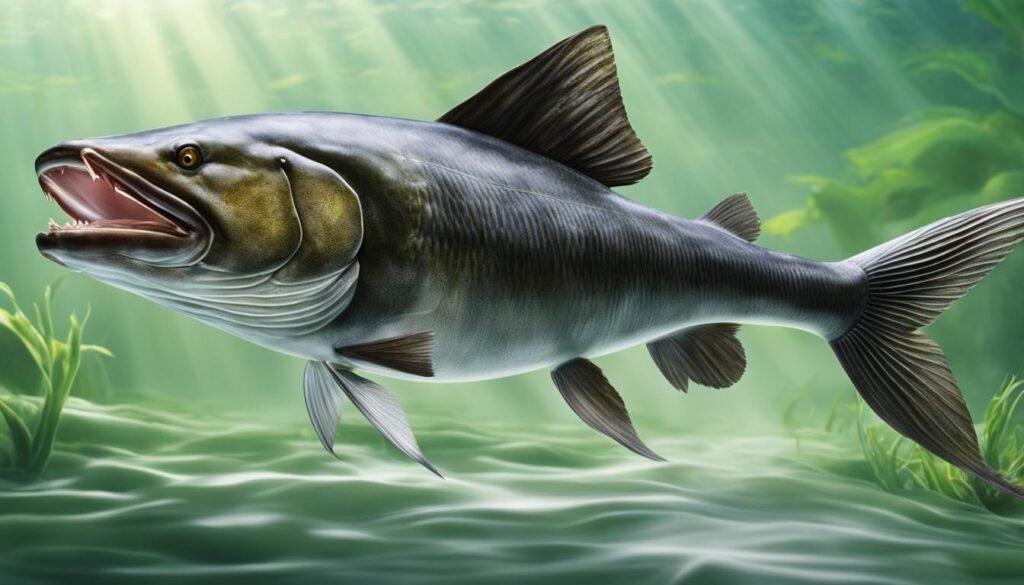
Dietary Habits and Predatory Behaviors
The wels catfish’s eating habits show it’s a top predator. It eats many different things, like fish, frogs, and bugs. It has also been seen jumping to catch birds or eating snakes.
It can even eat other catfish, showing its dominance. This behavior helps control the population of other species. It shows the complex nature of food webs in water.
In summary, the wels catfish is a marvel of nature. With its unique anatomy, huge size, and hunting skills, it’s a standout in freshwater environments. It’s an example of the wonders of biology.
Wels Catfish Growth and Reproduction
The journey of the wels catfish from egg to giant deep water fish is fascinating. Knowing how they grow and reproduce is key to keeping them thriving. Their life moves through spawning, hatching, and growing, each with important milestones.
Understanding the Catfish’s Lifecycle
A wels catfish’s life starts when a female lays up to 30,000 eggs per kilogram of her body weight. After that, the male takes over to protect the eggs until they hatch. This early stage is crucial for their growth later on.
Factors Influencing Growth Rates
Many things affect how fast wels catfish grow. Food is super important for them to get big and strong. Water warmth and living conditions also play a big role in their growth. Knowing these factors helps us understand what they need to live well.
| Life Stage | Duration | Growth Rate Influencers |
|---|---|---|
| Egg to Larvae | 3-10 days | Water temperature, oxygen levels |
| Juvenile | 2-4 years | Food availability, habitat structure |
| Adult | Indefinite | Competition, predation pressure, environmental factors |
There’s a clear link between the growth of wels catfish and their surroundings. Saving these fish means saving a part of our freshwater worlds. It’s about much more than just one species; it’s about keeping a vital ecosystem going.
Tracing the Native and Invasive Habitats of the Wels Catfish
The wels catfish has caught many people’s attention. Its ability to live in new areas and its impact on those ecosystems is serious. Originally from calm rivers and lakes in central to eastern Europe, it’s now found far from home. In these new places, it changes the local ecosystems, posing challenges but also creating opportunities.
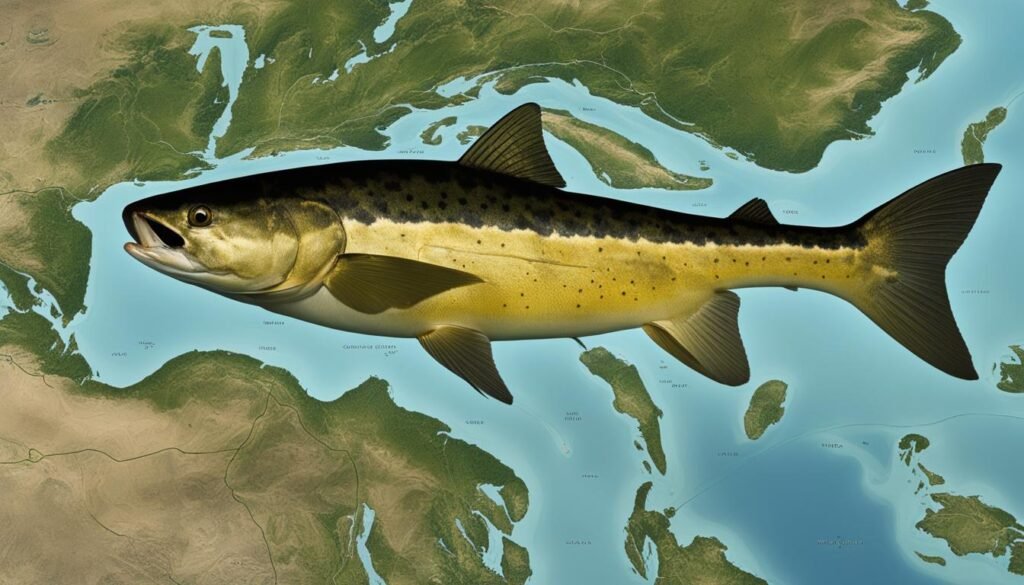
Looking at where the wels catfish came from and where it’s ended up, we see its effects on nature:
| Region | Native Habitat Characteristic | Invasive Habitat Characteristic |
|---|---|---|
| Europe – Baltic, Black, and Caspian Seas | Lowland rivers, backwaters, vegetated lakes | Adapted seamlessly, stable populations |
| United Kingdom | N/A | Introduced species, impacting local ecosystems |
| Western Europe | N/A | Thriving in varied water systems, raising ecological concerns |
| Kazakhstan, China | N/A | Non-native, gradually establishing populations |
| Greece, Turkey | N/A | Part of sports fishing, affecting indigenous aquatic life |
The wels catfish has shown it can adapt to many environments. Its movement into new areas highlights the need for good monitoring. This will help keep the balance in nature.
- Intensive research is ongoing to understand their impact on local species.
- Conservationists are taking steps to ensure biodiversity is not compromised.
- Fishermen and sporting communities continue to be fascinated by the potential enormity these creatures can achieve.
This fish’s spread from its native habitats to new invasive habitats highlights the need for careful management. It’s vital for the health of water ecosystems worldwide.
The Ecology and Impact of the Wels Catfish
The wels catfish plays a crucial role in its environment, going beyond just its size. As a top predator, it’s central to the balance of many water bodies. Studying it helps us understand and preserve different aquatic systems. Knowing its impact helps us keep ecosystems in balance.
Impacts on Native Species and Ecosystems
When wels catfish enter new waters, they can upset the existing balance. By competing with local species for food and space, they can reduce biodiversity. This can lead to fewer native species and disrupted breeding patterns, all because of the catfish’s presence.
Role as an Apex Predator in Various Water Bodies
As a dominant predator, the wels catfish helps control prey populations, supporting ecological health. It affects the food chain and competes with other predators. Having wels catfish in the water is a sign of a healthy ecosystem, showing the importance of their role.
| Impact Factor | Effect on Native Species | Effect on Ecosystems |
|---|---|---|
| Competition | Decreased population of smaller fish and invertebrates | Altered food chain dynamics |
| Predation | Decline in non-predatory species | Change in population structures |
| Habitat Alteration | Loss of breeding grounds for certain species | Modification of aquatic vegetation patterns |
The story of the wels catfish is filled with complex relationships and environmental details. As we study this fish in both its original and new homes, we must balance its needs with the ecosystem’s health. Through careful research and management, we can lessen its impact and protect our water ecosystems.
Record-Breaking Catches and Modern Observations of Wels Catfish
The thrill of catching the wels catfish mixes sport and the chance for records. These giants are part of stories that mix fact, myth, and fresh observations. This mix adds depth to fishing stories.
Record-Breaking Catches and Modern Observations
Fishermen in Europe talk about very big wels catfish. These catches set records. The details of these catches are well-noted, adding to the interest in the species. This data proves their size and helps us learn about their behavior and how they adapt.
Learning about these catfish is key for both saving them and fishing for fun. Here is a table showing some big catches. It lists things like weight and length, proving how big wels catfish can be.
| Year | Location | Weight | Length |
|---|---|---|---|
| 2015 | Po Delta, Italy | 280 lbs | 8.2 ft |
| 2018 | Mequinenza Reservoir, Spain | 247 lbs | 7.9 ft |
| 2021 | Fraser River, Canada (released) | 224 lbs | 9 ft |
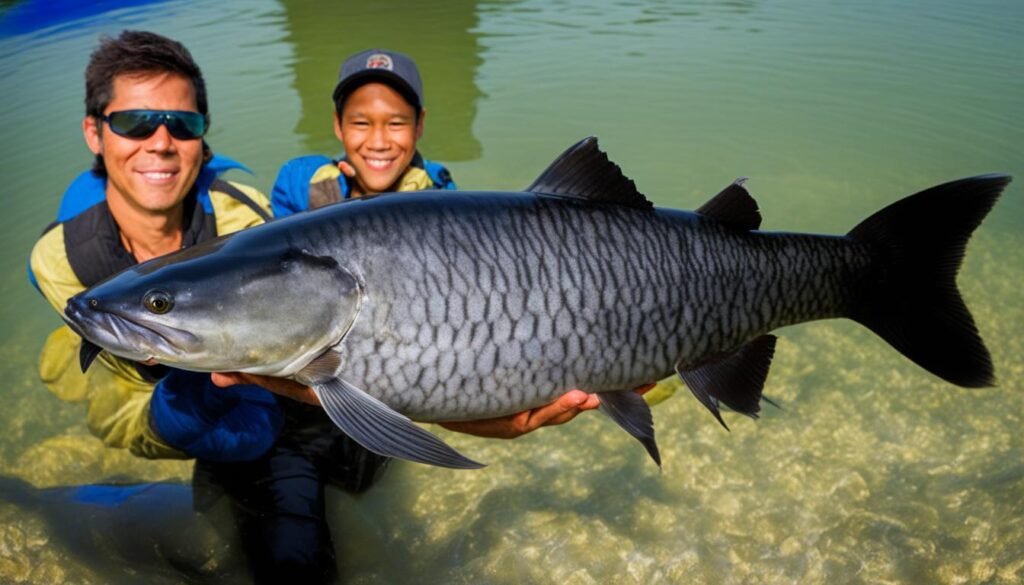
Human Encounters: Myths versus Facts
There are many myths about wels catfish. Some say they can swallow a person. Yet, it’s vital to know what’s real and what’s not. Meeting a real, huge wels catfish can teach us a lot. It shows their growth and their effect on nature.
Real findings have shown us the truth about wels catfish. This knowledge helps us treat these big fish right. It ensures we respect their place in nature.
As stories of wels catfish grow, so does our fascination. Whether believing myths or facts, we all agree: wels catfish keep us guessing about the water’s secrets.
Conservation and Management of the Wels Catfish Population
The wels catfish’s survival in both familiar and new areas depends on careful conservation and management. Changes in the environment and human activities challenge the species. Knowing about efforts to protect the wels catfish is crucial for its role in biodiversity and ethical fishing. Exploring these methods is vital. They help maintain and even improve the catfish’s chances of survival.
Conservation Efforts in Native and Non-native Regions
In their original homes, saving the wels catfish means protecting their natural living spaces. This includes laws to limit fishing and projects to fix their habitats. In areas where they are new, the goal is to keep nature in balance and avoid harming local waters. Keeping an eye on these efforts is key. They help keep a healthy mix of species in our ecosystems.
Addressing the Challenges of Overfishing and Habitat Loss
Overfishing and losing habitats pose big risks to wels catfish. Too much fishing and changes like city growth harm their living spaces. Plans to face these threats include laws, community efforts, and working together across countries.
| Conservation Challenge | Impact on Wels Catfish | Current Strategies |
|---|---|---|
| Overfishing | Population Decline | Quotas and Seasonal Restrictions |
| Habitat Loss | Reduction in Breeding Grounds | Habitat Restoration and Protection Programs |
| Invasive Species Competing with Catfish | Food Source Competition | Control and Eradication of Invasive Species |
| Pollution | Deteriorating Water Quality | Strengthening of Environmental Regulations |
| Unregulated Tourism and Recreation | Disturbance and Degradation of Natural Habitat | Implementation of Sustainable Tourism Practices |
Work to help the wels catfish is ongoing. Groups and governments work together to lessen negative effects. They seek a balance for the catfish’s well-being and for fishing activities. Rules may limit how many fish can be caught, when, and by what methods. This helps fish populations bounce back.
Local communities also play a key role in conservation. By spreading the word and supporting sustainable habits, real change happens from the ground up. This grassroots impact is often the most direct and effective. Consistent collective actions are essential. They ensure the wels catfish populations stay healthy, preserving their role in nature and culture for the future.
Wels Catfish in Popular Culture and as a Sport Fish
The wels catfish has moved beyond just river settings. It now grabs the attention of those in popular culture and those who love sport fishing. With its huge size, it’s not just a fish; it’s a challenge waiting in the river. Anglers are especially drawn to it, hoping to catch a giant.
This interest builds up the sport fishing community. It also makes the wels catfish a symbol of nature’s incredible aquatic creatures. It shows just how amazing and mighty the natural world can be.
The Appeal of Catching a River Giant
Anglers across the globe dream about catching a wels catfish. It’s a true battle of strength and wit, unlike any other. It embodies a massive challenge, testing those who try to catch it. These fish have become heroes in fishing stories, making them famous.
They’re known as giants of the river. They don’t just pull on fishing lines. They also tug on the hearts of anglers. This makes their reputation even stronger among those who chase after them.
Wels Catfish in Media: From River Monsters to Local Legends
The mysterious wels catfish is a star in many media stories. Shows like “River Monsters” have made it even more famous. These shows dive into dark waters and show off the catfish’s size and mystery. They confirm its status in aquatic legends.
At the same time, local stories turn it into a monster of the river. These tales mix myth with truth. They make locals and visitors curious. Everyone wants to know if the legends hold any truth.
Conclusion
We’ve journeyed through the aquatic realms of the wels catfish, discovering the largest freshwater fish in Europe. This true freshwater giant stands out with its size, often over 3 meters and 200 kilograms. It captures our imaginations and shows the wonders beneath our waterways.
This exploration highlighted the wels catfish as a wonder of nature, important to science, and cherished in fishing communities. The biology and ecology of the wels catfish reveal how well it fits its habitat. This summary touches on its significant impact on habitats, stressing the need for its preservation.
Conserving this species protects a fascinating creature and the health of ecosystems where it lives. As we conclude, it’s evident the wels catfish affects not just rivers but also people’s hearts. It enriches culture and excites sport fishing enthusiasts.
The story of the wels catfish, full of enchantment, keeps evolving. It reminds us of the incredible creatures we share our planet with. Let’s hope its tale encourages more respect, conservation, and responsible enjoyment of nature.
Learn More..
Is king mackerel a good fish to eat?
Are queen angelfish aggressive?
FAQ
How big can a wels catfish get?
The wels catfish is the biggest freshwater fish in Europe. Adults can be over 3 meters (9.8 feet) long and weigh more than 200 kilograms (440 pounds). But finding such big ones is rare today.
There are old stories of wels catfish reaching up to 5 meters (16 feet) and weighing up to 400 kilograms (880 pounds). Usually, they are about 1.3-1.6 meters (4-5 feet) long and weigh 15-65 kilograms (33-143 pounds).
What is the wels catfish and where is it found?
The wels catfish, or Silurus glanis, is a big freshwater fish in Europe. Its home is in central, southern, and eastern Europe, near the Baltic, Black, and Caspian Seas. It’s also been brought to places like the UK, Kazakhstan, and China.
Are there historical accounts of giant wels catfish?
Yes, the 19th century had stories of huge wels catfish, some as long as 3 meters (9.8 feet) and weighing 250 kilograms (550 pounds). These tales came from the Danube River and Lake Biel. People would talk about these giant fish they saw while fishing.
What are the unique anatomical features of the wels catfish?
The wels catfish has a big mouth with small teeth, two long barbels on its upper jaw, and four shorter ones on its lower jaw. Its body is long, letting it swim backwards. This fish is a top predator in its world.
How does the wels catfish grow and reproduce?
Female wels catfish lay up to 30,000 eggs for each kilogram of their weight. The male guards these eggs until they hatch. Their growth depends on things like food, where they live, and the water’s warmth.
Where can the wels catfish be found and what is its impact on ecosystems?
The wels catfish lives in central, southern, and eastern Europe. It got to other places and became invasive. As a top predator, it hunts and outcompetes other fish. This affects the balance in nature where it lives.
Have there been any record-breaking catches of wels catfish?
Yes, anglers have caught huge wels catfish, over 100 kilograms (220 pounds) and several meters long. These big catches make the wels catfish famous as a giant of the rivers.
What conservation and management efforts are in place for the wels catfish?
In places where it’s native, there are efforts to save its habitats and control fishing. Where it’s not from, they manage its numbers to protect local fish and ecosystems. This helps everyone.
What is the significance of the wels catfish in popular culture?
The wels catfish is popular for sport fishing because it’s so big and strong. It’s fun to try to catch such a giant fish. TV shows like “River Monsters” have made it even more famous.








